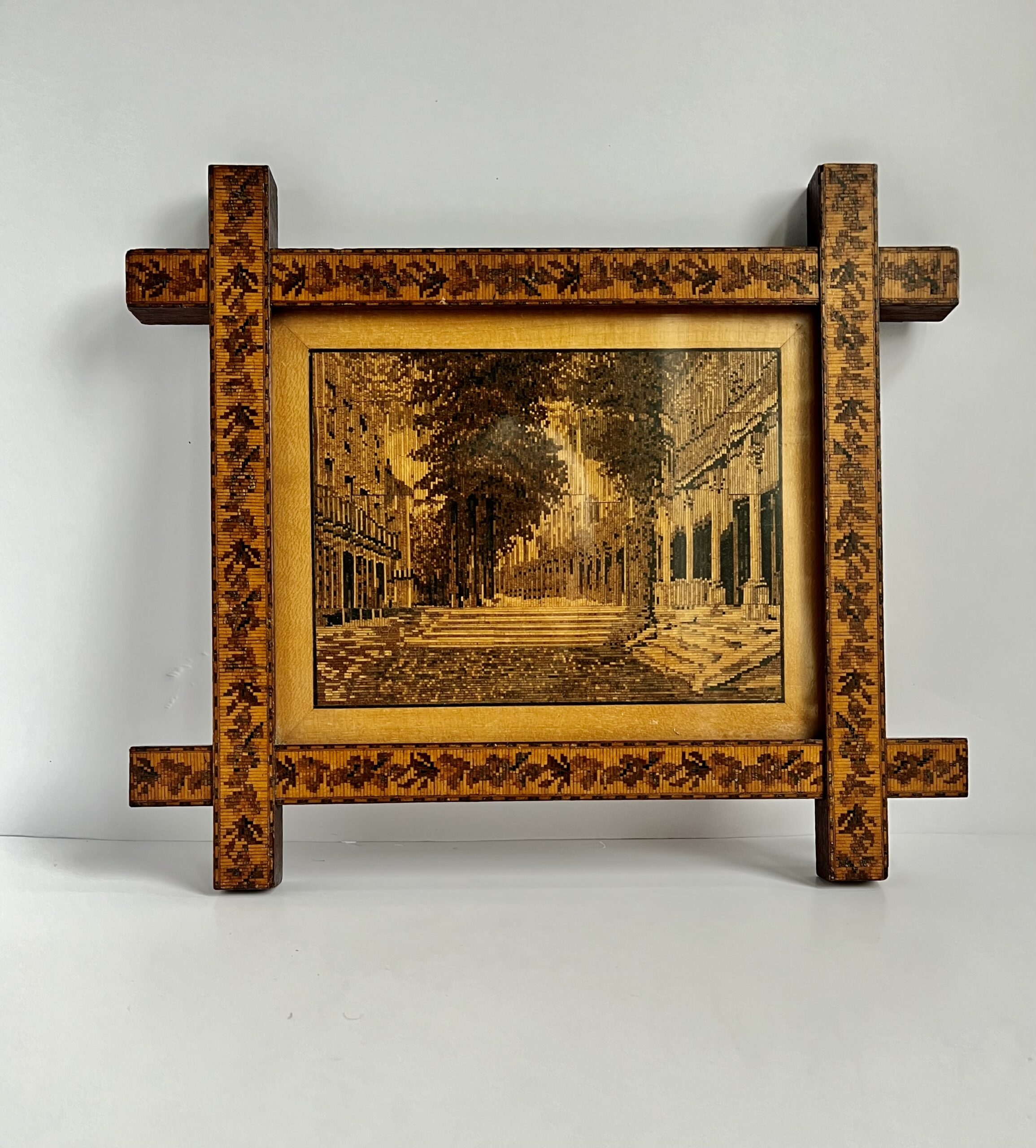
Tunbridge Ware Makers number 5: Henry Hollamby
September 25th, 2024
 Above: The Pantiles, Henry Hollamby’s magnum opus comprising 32,600 tessellated pieces, and over 100 different colours.
Above: The Pantiles, Henry Hollamby’s magnum opus comprising 32,600 tessellated pieces, and over 100 different colours.
History and work of Tunbridge Ware maker Henry Hollamby. 1819-1895
Henry Hollamby was a notable English craftsman best known for his work in Tunbridge ware, a form of decorative marquetry that originated in the town of Tunbridge Wells, Kent. His lifespan from 1819 to 1895 spans a significant period in the development of this craft, which was characterized by the intricate use of different woods to create beautiful patterns and designs.
During his career, Hollamby became known for his innovative techniques and designs, contributing to the popularity of Tunbridge ware as a collectible art form. He was part of a community of artisans who helped to establish Tunbridge Wells as a center for this craft, and his work was celebrated for its quality and aesthetic appeal. In addition to creating his own pieces, Hollamby may have played a role in mentoring other craftsmen and passing on the techniques of Tunbridge ware making, ensuring that the tradition continued beyond his lifetime. His legacy remains an important part of the history of decorative arts in England, and his works are still appreciated by collectors and historians today.
Background and Education.
Hollamby was born in 1819 in Kent, a region known for its rich natural resources that provided ideal materials for marquetry. The craft of Tunbridge ware became prominent in the 18th and 19th centuries, primarily as a result of the growing interest in decorative arts during the Victorian period. While specific details about Hollamby’s early training are scarce, it is likely that he apprenticed with his father in Tunbridge Wells, absorbing the techniques and styles of the time.
Techniques and Innovations.
Hollamby’s work is characterized by the intricate inlay techniques typical of Tunbridge ware, which involved cutting and assembling pieces of different woods to create elaborate patterns. Craftsmen like Hollamby used woods such as walnut, mahogany, and sycamore, often incorporating contrasting colors and textures to enhance the visual appeal. He may have experimented with various geometric designs and motifs, which often included floral patterns, landscapes, and scenes from nature.
Products and Popularity.
Hollamby produced a range of items, including snuff boxes,tea caddies,sewing boxes, writing slopes, and decorative trays, many of which were sold to tourists visiting Tunbridge Wells. The items often featured the trademark Tunbridge ware “tessellated” patterns, which were highly sought after during this period. His products not only served as functional objects but also as decorative art pieces, appealing to the Victorian fascination with craftsmanship and beauty.

Above: Glena Cottage, Kilarney, County Kerry Ireland. A rare piece.
Community and Influence.
Hollamby’s influence likely extended through his participation in local craft guilds and exhibitions, which were common during the Victorian period. These gatherings provided a platform for craftsmen to showcase their work and exchange ideas, fostering a sense of community among artisans. Henry Hollamby is credited with the development of mosaic blocks in Tunbridge ware that depicted topographical subjects, which marked a significant innovation in the craft during the Victorian era. This approach involved creating intricate images of landscapes, landmarks, and topographical features using small, precisely cut pieces of wood, which were assembled to form a cohesive and colorful picture.
Mosaic Blocks.
The mosaic blocks, often referred to as “topographical blocks,” were unique in that they combined the traditional techniques of Tunbridge ware with a focus on representing real-world scenes. These blocks typically featured detailed representations of local sites, including famous buildings, natural landscapes, and even maps of the area. The use of contrasting woods allowed for a vibrant palette that brought these images to life.

Above: Bayham Abbey, East Sussex
Artistic Techniques.
Hollamby utilized a technique known as “marquetry” to construct these mosaic blocks. This involved carefully selecting and cutting various types of wood to create a range of colors and textures. Each piece was meticulously shaped and fitted together to form intricate designs. The precision required to achieve the desired effect was a testament to Hollamby’s skill and attention to detail.
Topographical Subjects.
The subjects of Hollamby’s mosaic blocks often included local landmarks such as churches, bridges, and parks in and around Tunbridge Wells. By portraying familiar sites, these pieces not only served as decorative objects but also as souvenirs for visitors and residents alike. The ability to capture a specific location through art added a personal touch, making these items cherished keepsakes.

Above: Muckross Abbey, Killarney
Cultural Context.
During the Victorian era, there was a growing interest in natural beauty and local history, and Hollamby’s work resonated with this cultural trend. The detailed topographical representations allowed people to connect with their surroundings and celebrate local heritage. Additionally, these mosaic blocks reflected the broader Victorian fascination with craftsmanship, artistry, and the appreciation of nature.
Legacy.
Henry Hollamby’s development of mosaic blocks depicting topographical subjects contributed to the evolution of Tunbridge ware, elevating it from mere decorative art to a form that encapsulated local identity and pride. His innovative approach not only enhanced the aesthetic appeal of his work but also ensured that it held cultural significance, making his pieces highly sought after by collectors today. The legacy of his techniques and the themes he explored continue to inspire contemporary artisans who seek to capture the essence of their surroundings through their craft.

Above: Bird of Prey.
All the above featured Tunbridge Ware pieces in this Blog are for sale on my Website: https://tunbridgeware.uk/



